Smoking Crematory Chimney at Auschwitz: A Correction
Eyewitnesses of the Auschwitz-Birkenau camp have frequently testified that thick smoke belched out of the chimneys of the four crematories of that camp. One classic example is the testimony of former Auschwitz inmate Arnold Friedman. While being cross-examined about his experiences at Auschwitz, Friedman stated during the first Zündel trial in 1985:[1]
“There was smoke belching from the crematoria, and it gave us a constant smell – the crematoria being close enough and low enough for the smoke to be dispersed through the camp rather than go straight up.”
The paintings by former Auschwitz inmate David Olère, who claims to have lived in one of the Birkenau crematories for almost two years, give an artistic rendering of the general theme that pervades Auschwitz survivor statements. I give here only one example of the many Olère has drawn and painted, see Ill. 1.[2]
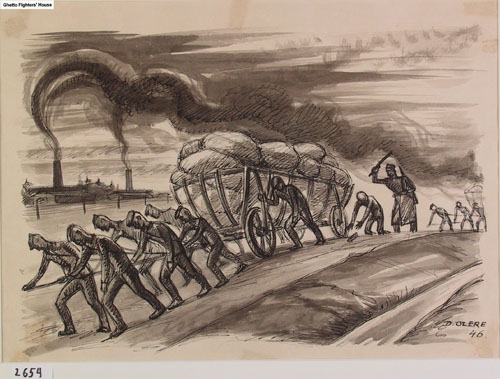
Also according to witness statements, the Birkenau crematories are said to have been in basically uninterrupted operation from May 1944 into the late summer of 1944, when the Nazis are said to have exterminated up to half a million Jews from Hungary and up to 70,000 Jews from the Lodz Ghetto.
At the same time, Allied reconnaissance airplanes took several air photos of the camp. Hence, if the witnesses’ claims were true, we would expect to see thick smoke emanating from at least some of the crematory chimneys on at least some of these photos. In his trail-blazing work on air photo evidence about the Holocaust – or rather the lack thereof – John C. Ball has reproduced several of these reconnaissance photos which had been released to the public by that time. He posited that none of them show any smoke-emitting crematory chimneys.[3]
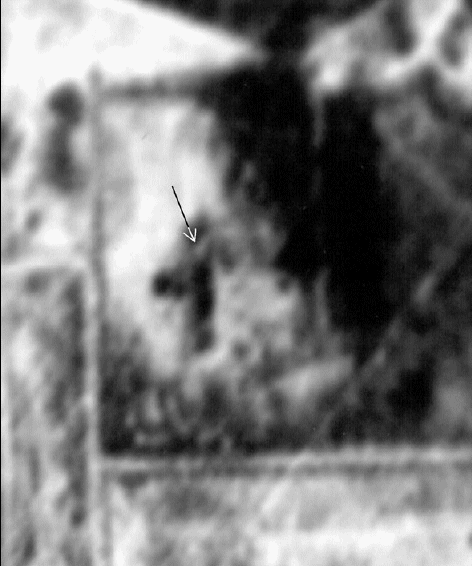
However, in his impressive 2005 work on open-air incinerations at Auschwitz, Carlo Mattogno hypothesized that one air photo taken by a Canadian reconnaissance airplane on August 20, 1944, over the Birkenau camp “shows a dense column of smoke rising in a spiral from the chimney of crematorium III.” See Illustration 2.[4]
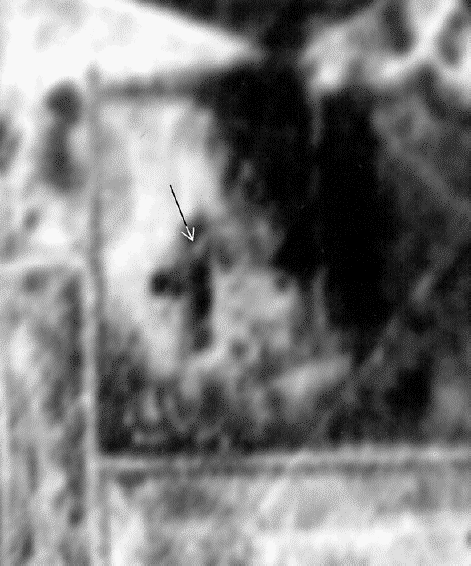
Although I do not wish to argue here that coke-fired crematory chimneys of that era did not emit smoke, I will show in the following that Mattogno’s air photo evidence is flawed. In fact, what is visible on that particular air photo is not smoke from a chimney, as Mattogno claimed (see my Ill. 1), but rather a defect in the photograph.
As can be seen on the Aug. 20 photo, there are several slanted lines crossing the photo, which are probably mere scratches caused during some step of the film’s processing/storing. One of these slanted lines happens to run across Crematory III, causing a bright smudge which appears to be smoke. Lots of these smudges can be seen in other parts of the photo as well, especially in contrast with the almost black ground in the right-hand part of the photo. I have highlighted some of these scratches in an animate GIF image, see Ill. 3. The second frame has a few of the parallel scratches marked with thin red lines. As the reader can easily see, there are many more scratches. In fact, the entire photo is covered with them. These lines are not visible on the Aug. 23 photo, which is of a much better quality.[5]
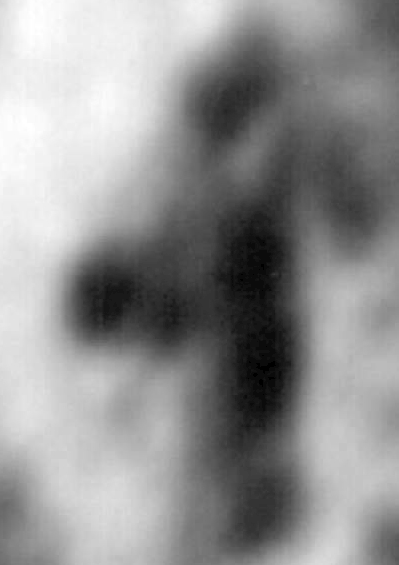
To support my assertion, I wish to make a few additional points:
- The actual chimney is located roughly in the center of the side wing of the crematory building, which extends toward the left on the photo. Yet the bright, hence thickest part of the alleged “smoke” is located on the roof of the building’s main wing, some 10 meters away from the actual chimney location. There is no bright smudge above the chimney itself. I posit that it is quite impossible for a coke-fired crematory to emit smoke in occasional spurts, leading in this instance to its most conspicuous visibility some 10 m away from the source. The smoke should actually be more visible closer to the source rather than not visible at all.
- Smoke rising from a chimney always produces a conical shape (or a triangle on a 2D projection = photo), which widens with increasing distance from the source. But if we take an even closer look at the image, Ill. 4, it turns out this “smoke” appears to be tapering off with increasing distance from the chimney. Real smoke behaves differently: It is thick and focused at the source, but thins out and widens in the distance. To prove that point, see the actual smoke cone rising from the yard of Crematory V, see Ill. 4. This brings up my final point.
- The wind direction on this photo is from the south to north as shown by the real smoke coming from the yard of Crematory V, but this alleged “smoke” coming from Crematory III has a direction from southeast to northwest, parallel to all the other scratches. See the arrows on Ill. 5.
My conclusion is therefore that this is only an error/artifact on the photo, since the entire photo is covered by these slanted scratch lines in the same direction as the one marked by a red arrow over Crematory III. One of these scratches anomalously produced the illusion of smoke rising from that chimney.
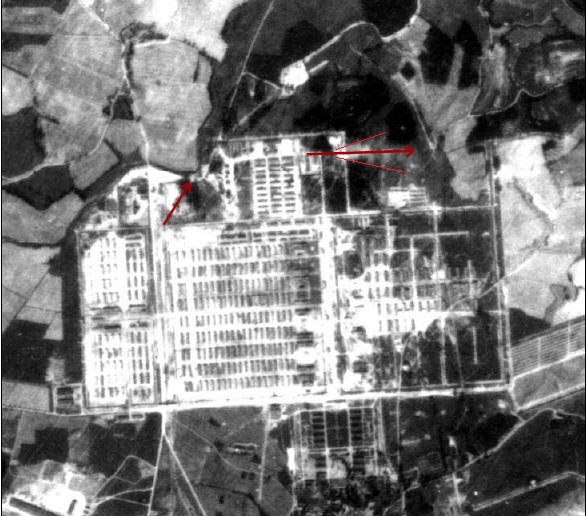
[Click for larger image without arrows.]
Notes:
| [1] | District Court of Ontario. Between: Her Majesty the Queen and Ernst Zündel. Before: The Honourable Judge H.R. Locke and Jury (verbal record of the “first Zündel” trial of 1985), p. 315; similar on pp. 326, 344, 347; cf. Michael Hoffmann, The Great Holocaust Trial, 3rd ed., Wiswell Ruffin House, Dresden, NY, 1995, pp. 45-47. |
| [2] | To see more of Olères’s artwork, see at http://fcit.usf.edu/holocaust/resource/gallery/olere.htm or search the Ghetto Fighters House Archive for his name, where the one reproduced here can also be found. |
| [3] | John C. Ball, Air Photo Evidence, publ. by author, Delta, B.C., 1992, esp. pp. 64f. |
| [4] | Carlo Mattogno, Auschwitz: Open Air Incinerations, Theses & Dissertations Press, Chicago 2005, p. 64, referring to Doc. 34f. on pp. 115f. Note: the photo enlargement on p. 116 wrongly refers back to Doc. 31; it should be Doc. 34. |
| [5] | Ibid., Doc. 36, p. 117. |
| [6] | Ibid., Docs. 33 & 38, pp. 114, 119. |
Bibliographic information about this document: Inconvenient History, vol. 4, no. 4, 2012
Other contributors to this document: Germar Rudolf: editing and animated illustrations
Editor’s comments: Slightly edited. The first illustration and the animated illustrations were submitted to IH, but not published. Static illustrations were used instead.
